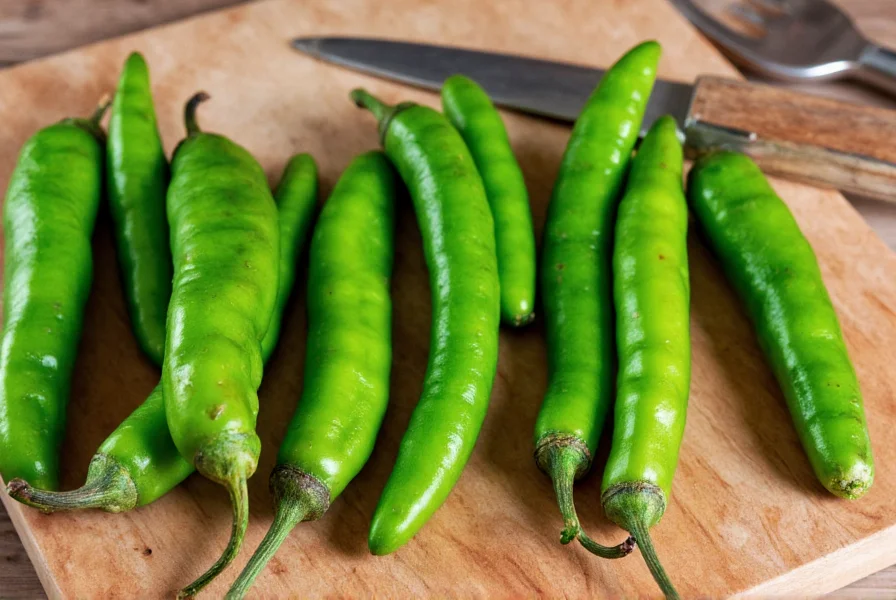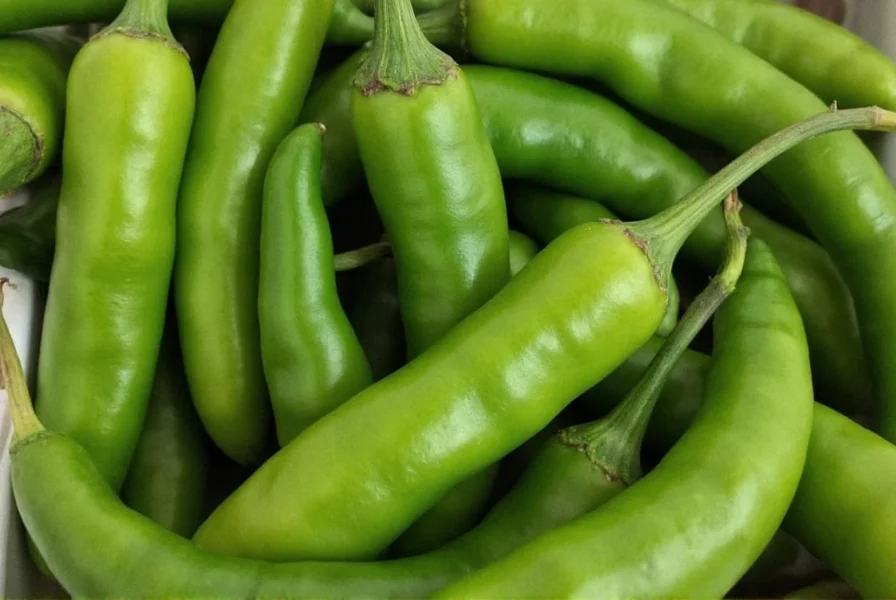Hatch green chilies represent a culinary treasure from the Hatch Valley region of New Mexico, where ideal growing conditions create peppers with complex flavor profiles unmatched by generic "green chilies." Unlike canned alternatives, authentic Hatch chilies have a seasonal availability window from late August through September, making them a prized ingredient during harvest season. Their unique terroir—combination of soil composition, altitude, and climate—gives these peppers their characteristic earthy, slightly sweet taste with subtle grassy notes.
Origin and Regional Significance
The Hatch Valley in southern New Mexico has cultivated chilies since the 1500s when Spanish settlers introduced them to Native American communities. Today, the region produces approximately 75% of New Mexico's chile crop, with the town of Hatch serving as the epicenter of production. The Capsicum annuum variety grown here develops distinctive characteristics due to the area's 3,000-foot elevation, abundant sunshine, and mineral-rich soil.
What distinguishes genuine Hatch chilies from other green chilies? The New Mexico Chile Advertising Act of 2018 legally protects the "Hatch" name, requiring peppers to be grown within the Hatch Valley region to carry the designation. This geographical indication ensures consumers receive authentic product with consistent quality and flavor.
Flavor Profile and Heat Characteristics
Hatch green chilies offer a nuanced flavor experience that varies by specific variety and growing conditions:
| Variety | Heat Level (Scoville) | Flavor Notes | Best Culinary Uses |
|---|---|---|---|
| Mild | 1,000-2,500 | Grassy, vegetal, slightly sweet | Salads, sandwiches, mild sauces |
| Medium | 3,000-5,000 | Earthy, smoky, balanced heat | Enchiladas, stews, roasted dishes |
| Hot | 5,000-7,000 | Peppery, complex, lingering heat | Salsas, hot sauces, bold recipes |
Unlike jalapeños which deliver immediate heat, Hatch chilies provide a gradual warmth that builds slowly, allowing their complex flavors to shine through. The heat level varies significantly based on growing conditions—drier seasons typically produce hotter peppers, while wetter seasons yield milder varieties.

Seasonality and Availability
Understanding when is hatch green chili season proves crucial for enthusiasts. The harvest runs from late August through September, with peak availability in early September. During this period, local farmers' markets in New Mexico feature freshly roasted chilies, while specialty grocers nationwide receive shipments.
For those outside New Mexico, frozen roasted Hatch chilies provide the most authentic off-season option. Canned versions exist but often lack the nuanced flavor of freshly roasted peppers. When selecting fresh Hatch chilies, look for firm, glossy skins without wrinkles or soft spots—these indicate peak freshness.
Proper Roasting and Storage Techniques
How to roast hatch green chilies properly transforms their flavor profile. The traditional method involves charring over open flame:
- Place whole peppers directly over gas flame or under broiler
- Rotate frequently until skin blisters and blackens (5-8 minutes)
- Transfer to paper bag and seal for 10 minutes to steam
- Peel away charred skin, remove seeds if desired
- Rinse briefly to remove stubborn skin fragments
For long-term storage, roasted Hatch chilies freeze exceptionally well. Portion them into recipe-sized amounts (typically 1-2 peppers per portion) in freezer bags, removing as much air as possible. Properly stored, they maintain quality for 10-12 months. Never store unroasted fresh chilies in plastic bags, as this accelerates spoilage.
Culinary Applications and Pairings
The versatility of Hatch green chilies makes them suitable for numerous dishes. Their flavor complements:
- Cheese-based dishes (especially Monterey Jack and cheddar)
- Egg preparations (frittatas, omelets, breakfast burritos)
- Creamy sauces and soups
- Marinades for chicken and pork
- Bean dishes and rice preparations
When comparing hatch green chili vs poblano, note that while similar in appearance, Hatch varieties typically offer more complex flavor and slightly higher heat. Poblanos work as substitutes but lack the distinctive smokiness that defines roasted Hatch chilies.

Nutritional Profile and Health Benefits
Beyond their culinary value, Hatch green chilies offer notable nutritional advantages. A single roasted pepper (about 45g) contains:
- Only 15 calories
- 3 grams of dietary fiber (12% of daily value)
- 100% of daily vitamin C requirements
- Significant vitamin B6 and potassium
- Antioxidants including capsaicin and flavonoids
Research suggests regular consumption of chili peppers like Hatch varieties may support cardiovascular health, boost metabolism, and provide anti-inflammatory benefits. The hatch green chili nutritional benefits make them a valuable addition to balanced diets.
Common Misconceptions
Several myths surround Hatch green chilies:
- Myth: All green chilies labeled "Hatch" come from Hatch Valley
Fact: Only peppers grown in the designated region can legally use the name - Myth: Hatch chilies are always extremely hot
Fact: Mild varieties exist with heat levels comparable to bell peppers - Myth: Canned Hatch chilies equal fresh roasted
Fact: Canning process diminishes complex flavor notes
Where to Source Authentic Hatch Chilies
Finding genuine Hatch green chilies requires some effort outside New Mexico. During peak season (August-September), check:
- Specialty grocery stores with robust produce sections
- Online retailers specializing in regional foods
- Local farmers' markets in larger cities
- New Mexico-based distributors shipping nationwide
When shopping, look for the official Hatch Chile logo—a red and green chile pod with "Hatch" written beneath. This certification mark guarantees authentic origin. Understanding where to buy hatch green chilies ensures you receive the genuine product rather than generic substitutes.
Conclusion
Hatch green chilies represent more than just a regional specialty—they embody a culinary tradition shaped by unique environmental factors. Their seasonal availability, distinctive flavor profile, and versatility in cooking make them worth seeking out during harvest season. Whether you're roasting them for immediate use or freezing for year-round enjoyment, properly handled Hatch chilies elevate dishes with their complex, smoky character that generic green chilies cannot replicate. For authentic Southwestern cooking, few ingredients deliver the same depth of flavor as these celebrated New Mexico peppers.
Frequently Asked Questions
What makes Hatch green chilies different from regular green chilies?
Hatch green chilies are grown exclusively in the Hatch Valley region of New Mexico, where specific soil composition, altitude, and climate create peppers with distinctive flavor characteristics. Unlike generic green chilies, authentic Hatch varieties have legally protected geographical indication status and develop complex smoky, earthy notes when roasted properly.
How hot are Hatch green chilies compared to other peppers?
Hatch green chilies range from mild (1,000-2,500 Scoville units) to hot (5,000-7,000 Scoville units), placing them between poblanos and jalapeños in heat intensity. The actual heat level varies based on growing conditions—drier seasons produce hotter peppers while wetter seasons yield milder varieties. Unlike jalapeños that deliver immediate heat, Hatch chilies provide gradual warmth that allows their complex flavors to shine.
What's the best way to store roasted Hatch green chilies?
The optimal storage method for roasted Hatch green chilies involves portioning them into recipe-sized amounts (typically 1-2 peppers per portion) in freezer bags with as much air removed as possible. Properly stored, they maintain quality for 10-12 months in the freezer. Never store unroasted fresh chilies in plastic bags, as this accelerates spoilage. For short-term storage (3-5 days), keep roasted chilies in airtight containers in the refrigerator submerged in a small amount of water.
Can I substitute other peppers for Hatch green chilies?
While poblano peppers offer the closest visual match to Hatch green chilies, they lack the distinctive smoky flavor profile. For best results, use a combination of poblano peppers and a small amount of Anaheim or jalapeño peppers to approximate the flavor complexity. During Hatch season (August-September), frozen roasted Hatch chilies provide the most authentic substitute when fresh ones aren't available. Canned green chilies make the least suitable substitutes as the canning process diminishes their nuanced flavor characteristics.











 浙公网安备
33010002000092号
浙公网安备
33010002000092号 浙B2-20120091-4
浙B2-20120091-4